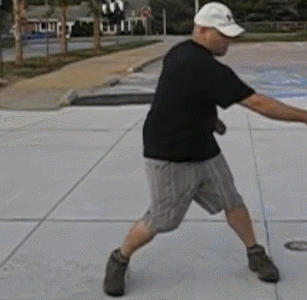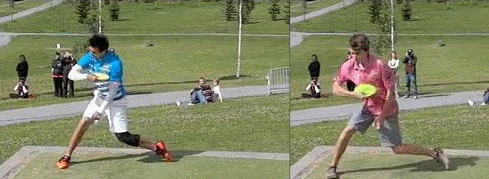- Joined
- Nov 2, 2008
- Messages
- 22,104
FWIW I found Brad's Closed Shoulder Drill to supplant the actual Right Pec Drill. There's still a ton of great info the Beto vid and from the closed shoulder drill you work the hit backwards.
Discover new ways to elevate your game with the updated DGCourseReview app!
It's entirely free and enhanced with features shaped by user feedback to ensure your best experience on the course. (App Store or Google Play)
I believe that's the difference between half hit and full hit. Half hit is more passive wrist that gets slammed open. Many top throwers say their wrist only moves a tiny bit during the hit. Tighter spring = more potential.Which leads to another question I've never gotten a satisfactory answer to. At the very end do you actively open your wrist or do you just let the combined momentum of everything leading up to that point force the wrist open? I've always thought the latter, but I've never been sure about that.
Interesting. So is this something you can make yourself do or is it just how you throw? If I think about opening my wrist, I also tend to release my grip. So it seems easier to just try to lock it down and let it happen. But I guess the whole gripping while releasing thing is pretty counter intuitive for everyone.I believe that's the difference between half hit and full hit. Half hit is more passive wrist that gets slammed open. Many top throwers say their wrist only moves a tiny bit during the hit. Tighter spring = more potential.
I don't think HUB is referencing the disc clock in the train analogy.
I believe that's the difference between half hit and full hit. Half hit is more passive wrist that gets slammed open. Many top throwers say their wrist only moves a tiny bit during the hit. Tighter spring = more potential.
Yup dead on.
You will notice that when trying to do this with a bent wrist, as the wrist uncurls your fingers want to let go of the disc before you get to the hit.
The only movement in my wrist at the hit is when I actively adjust the nose angle. The main focus is extending everything forward, not so much spinning/uncurling it.
But what about Wysocki? He actively curls his wrist and hucks a good long way.
It seems there is always somebody throwing well with a technique that otherwise seems flawed. Your thoughts?
that doesn't make it good for you.
michael jordan could have rubbed icy hot on his nuts before every game and he still would've wiped the court with everybody's face.
it's sort of like holding your disc during the reach back. some players that throw a long way can probably do that...but can you? wouldn't it be easier to start with a clean slate, devoid of bad habits that inhibit your fundamentals?
*shrug* there's always an outlier.
also i'd like to know if you're talking about wysocki's forehand vs. his backhand, because that's kind of a big difference.
good explanation, OP, but i'm not sure i like how complicated the "release station" jargon is becoming. it's a concept that helps envision where we need to be. it is good and i like it, but there are simpler ways of explaining the rest than trying to make it all fit into this analogy.
There's a big difference between curling and cocking. Most the footage and in person I've seen from Ricky in the past is a fairly straight to slightly cocked wrist. I have seen more recent footage where he seems to cock it back, which maybe more for aiming rather than raw power.But what about Wysocki? He actively curls his wrist and hucks a good long way.
It seems there is always somebody throwing well with a technique that otherwise seems flawed. Your thoughts?
One thing you're touching on that is important for people to grasp is that you shouldn't be trying to throw the disc hard. You're mind shouldn't be focusing on pulling fast and ripping one because if that's your mindset you're going to lose focus on the small moment of acceleration that actually matters.
that doesn't make it good for you.
michael jordan could have rubbed icy hot on his nuts before every game and he still would've wiped the court with everybody's face.
it's sort of like holding your disc during the reach back. some players that throw a long way can probably do that...but can you? wouldn't it be easier to start with a clean slate, devoid of bad habits that inhibit your fundamentals?
You need to find the similarities between the styles....the sequence and timing. Compare any non-top thrower to this and you will see the disc is way off during the backswing, transition, and forward swing as well as the followthrough.I was watching Wysocki fairly closely at the Maple hill open last month, where I was there in person, and noticed he reaches back (not out) and high, with his wrist pre-curling the disc.
Also relevant is to this is the discussion of not worrying too much about the reach back at all - however, Shusterick makes a point in one of his videos to emphasize the importance of reaching back far.
This isn't about this:
I'm very much concerned with not spending too much time learning bad fundamentals and have rebuilt my backhand throw several times already after realizing I was strong-arming too much. The thing is, when you start digging into the matter in more detail, you will find fairly contradictory approaches extolled by different people, and even greater differences in how people actually throw.
I was surprised at Maple Hill to see some of the pros throw pretty damn far with what to me seemed to my eye to be poor (or at least not especially clean) technique.
Obviously, individual adjustments to their own physical particulars will account for some things. But when you see Feldberg throwing a backhand with a straight arm, or McBeth barely even looking back, or Wysocki curling his wrist, or Shusterick reaching way back, and seeing they all do pretty well, then it does bring a certain confusion to the topic of 'how is the backhand done the best way?'

